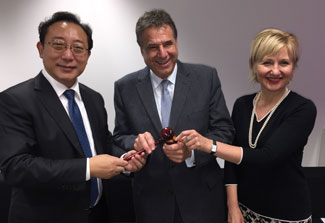The Global Alliance for Chronic Diseases: a partnership blossoms
January / February 2016 | Volume 15, Issue 1

Photo courtesy of the GACD
Outgoing GACD chair, Dr. Xuetao Cao of China, hands the
gavel toincoming chair, Dr. Alain Beaudet of Canada, while
chair-elect, Dr. Glenda Gray of South Africa, offers
congratulations.
Opinion by Fogarty Director Dr Roger I Glass
The new year brings fresh enthusiasm to tackle our most pressing global health challenges - especially the emerging tide of chronic, noncommunicable diseases that threaten the progress we've made against HIV and infectious diseases in low- and middle-income countries.
I'm encouraged by the great strides we've made in building an international collaboration to address this problem, the Global Alliance for Chronic Diseases (GACD). Begun in 2007 with four founding members, the partnership has grown to include the European Commission and research funding bodies in nine countries - Argentina, Australia, Canada, China, India, Mexico, South Africa, the U.K. and the U.S. - with more preparing to join. The GACD was established to facilitate collaborative funding activities for innovative, original research directed at the prevention and treatment of chronic diseases. Celina Gorre is the Executive Director of the GACD Secretariat, which is hosted by the University College London.
The amount invested has risen with each GACD funding call, from $22 million for research on hypertension in 2011, to $30 million for diabetes in 2013, to $50 million for lung disease in 2015. Another metric of growth is the increasing attendance at the annual scientific meetings, with the most recent meeting in Mexico City attracting more than 100 scientists.
GACD participants decided that funded research projects should meet several criteria. They must involve local policymakers from the outset, with a commitment to investigate research on the implementation of programs that could be scaled up if successful. Clinical outcomes should be measured - for example, a reduction in the incidence of stroke or a drop in the prevalence of untreated hypertension. The research should not cause human and other resources to be diverted from local health systems. Deliverables should include a toolkit that can be used to scale up successful programs. Finally, and significantly for Fogarty, each project should include a training and capacity building component.
The GACD leadership has successfully navigated numerous issues of governance and the mechanics of operation. We hope to reach the stage where we can conduct joint peer review and there are metrics that show this is a viable goal.
We are in good hands with a management committee made up of new chair Dr. Alain Beaudet, president of the Canadian Institutes of Health Research, future chair Dr. Glenda Gray, president of South Africa's Medical Research Council, and past chair Dr. Xuetao Cao, president of the Chinese Academy of Medical Sciences. At our recent meeting, I was pleased to observe that three former Fogarty trainees are engaged in this important effort - Gray, Dr. Soumya Swaminathan, director general of the Indian Council of Medical Research, and Dr. Daniel Gomez, of Argentina's Ministry of Science, Technology and Productive Innovation. This assemblage of talent is a powerful testament to the impact of Fogarty's capacity building programs.
As a member of the GACD Board, I am proud to represent NIH, which now has nine entities as committed collaborators: the National Cancer Institute (NCI), National Heart, Lung and Blood Institute (NHLBI), National Institute of Biomedical Imaging and Bioengineering (NIBIB), Eunice Kennedy Shriver National Institute of Child Health and Human Development (NICHD), National Institute of Environmental Health Sciences (NIEHS), National Institute of Mental Health (NIMH), National Institute of Neurological Disorders and Stroke (NINDS), the Office of Research on Women's Health (ORWH) and Fogarty. Dr. Pamela Collins and colleagues at NIMH will help lead the upcoming scoping exercise, to determine how best to structure a call for proposals to study implementation issues related to the mental health agenda.
Currently, six NIH components are involved in the most recent call for proposals around environmental lung diseases: NCI, NHLBI, NICHD, NIEHS, the NIH Common Fund and Fogarty. And NHLBI and NINDS may play an active role in discussions to plan a new funding call to engage countries that are studying interventions for hypertension.
The population of most countries in the world are aging, and as they do we will all ultimately be burdened with some of the most common chronic diseases. To accelerate discovery, we need to access the brainpower of researchers around the globe. The GACD today provides a new path to advance research in prevention and cures by joining together the world's largest funders to develop scientific networks that improve the lives of us all.
More Information
To view Adobe PDF files,
download current, free accessible plug-ins from Adobe's website.